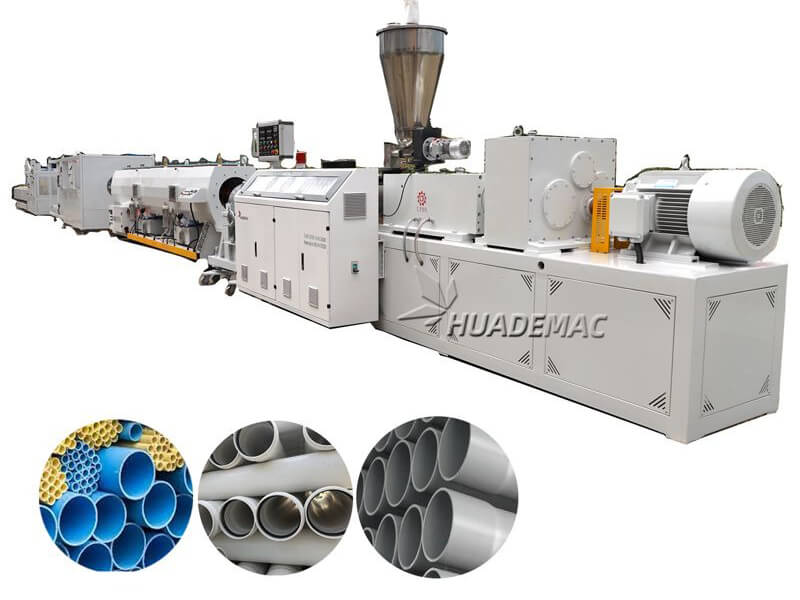Manufacturer of pipe technology solutions
- Any Questions?[email protected]
- Get in Tough+86-13601562675

1. The operator should be familiar with the emergency stop button and the work flow of this position, and can deal with it in the event of an emergency.
2. Manually add the machine material every time the machine is turned on, and after the cover is closed, observe whether the extruder exhaust port has material adhered to it.
3. The distance between the sizing sleeve and the die should not be too close (125px~250px).
4. When starting up normally, pay attention to the extruder load (current), and the load data cannot rise too fast, and the twin-screw speed and manual feeding speed should be slowly increased.
5. When stopping normally, it should be noted that the load of the extruder cannot exceed the normal value.
6. There should be no water droplets on the upper surface of the pipe between the cooling vacuum and the tractor, and it should be clean and free of water.
7. The nozzle of the inkjet printer should be removed every time the material is cut off, and the length of the pipe should be measured with a steel tape measure.
8. Fill in the "Extrusion Process Parameter Record" according to the process control index of this post.
1.The inspection time should be every 15 minutes/time, weigh the product once every hour and fill in the "Product Weighing Record Form".
2. Inspection content
1) Whether there is material in the barrel of the feeding machine, and whether the feeding machine is working normally.
2) Check whether the oil level of the extruder gearbox, the feeding gearbox and the screw is normal, whether the cooling water of the gearbox and the water source of the vacuum pump are circulating, and clean the filter screen at the water inlet in time.
3) Check whether the main engine temperature is abnormal, the main engine speed and current, the feeding speed and current, and whether the melting pressure and melting temperature are normal.
4) Check whether the vacuum of the main engine is normal, generally between 0.04-0.06MPa.
5) Check the barrel and mold heating line for damage, and observe whether the discharge of the die is smooth.
6) Check whether the vacuum of the sizing box is normal. It is generally between 0.02-0.04 below 200, and between 0.04-0.06MPa above 200. Check whether the water level of the sizing box is normal, and whether the pressure of the water gauge is normal. Water strainer.
7) Check whether the inkjet printer is working normally, whether the font size of the inkjet code is appropriate, whether the handwriting is missing, and whether the ink and solvent are missing.
8) Check whether the oil level of the tractor motor reduction box is normal, whether the pressure is normal, whether the jaws tighten the pipe normally, and whether there is any deformation offset.
9) Check whether the cutting machine has an alarm, whether the hydraulic oil is lacking, and clean the sawdust once an hour, check whether the cutting saw belt is loose, whether the feed and retract screws are loose, and clean the sawdust in the motor junction box.
10) Measure the wall thickness, outer diameter and length of the pipe, and make a record. If it is found that the wall is biased, the thickness is not allowed, and the length and outer diameter are not allowed to report and modify it in time.
11) Check whether the surface of the pipe is smooth and whether there are dents and cracks, and report and deal with it in time.
12) Observe whether the hydraulic oil, water and electricity of the flaring machine are normal. Pay attention to whether the feeding, heating, bracket translation, forward and backward pulling, and forward and backward of the flaring die are working properly.
13) Check whether each photoelectric switch is in the normal working position and working state.
14) Check whether the flaring of the pipe after flaring is good and whether there is any offset.
15) The pipes are put into storage to reduce scratches and falls. Each post should be dedicated to each inspection department, find faults in time, deal with them when they have the ability to deal with them, and report to the monitor when they are not sure, and must not deal with them without permission. If there is a fault in each post for a long time to find or report, the individual will be warned after discovery, and the individual will be held accountable for downtime or equipment damage.
1. When equipment failure affects safe production, the operation must be stopped immediately. If the equipment failure is not eliminated, it cannot be restarted.
2. The operator must wear protective equipment, and the hair should not be over the shoulder to ensure the safety of personal and equipment.
3. The equipment protection device cannot be dismantled at will or left unused.
4. The operator cannot stand beside the die or extruder to heat or bake other items.
5. When the operator installs the mold, the body cannot face the discharge port of the extruder.
6. When cleaning the printer, the spray liquid cannot be sprayed at people.
7. Strictly control various process indicators to ensure the smooth progress of safe production.